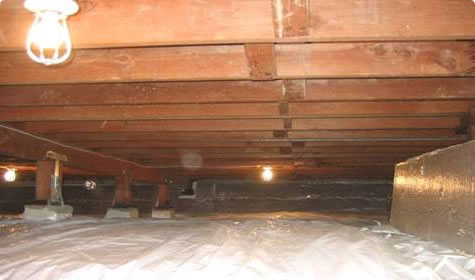 |
 |
 |
Damage to homes from moisture infiltration or pests gives homeowners endless headaches. It can also wind up requiring extensive and expensive repairs. What's more, moisture penetration can create conditions for excessive mold growth, which can wind up causing health problems for the residents.
Read on for advice on keeping out moisture and pests before they become a problem.
Crawl spaces
Crawl spaces are common underneath California homes. Unfortunately, most crawl spaces are underventilated and are often the source of moisture problems in the home. Retrofitting crawl spaces can help reduce moisture problems.
Control ground moisture by covering the entire crawl space floor with a durable vapor barrier (plastic sheeting that is at least 6 mil thick). The vapor barrier can be installed by a building professional or a handy homeowner. Overlap the sheets, pin them to the ground, seal the seams with tape and then apply mastic over the tape. Carry the vapor barrier up the foundation wall as far as possible, preferably above the level of the exterior soil.
Prior to installing the vapor barrier, consider installing a French drain system outside the foundation wall and in the crawl space to divert bulk water. Consult a moisture control expert for your specific situation.
If appropriate, consider going a step further by completely sealing and conditioning the crawl space. This involves insulating the crawl space walls, closing the vents, and bringing into the crawl space a small amount of conditioned air from the home's heating and cooling system. Consult with your local building department and follow best building science practices. For more information, visit www.buildingscience.com.
Flashing
Flashing is a thin layer of impervious material installed underneath exterior siding and roofing materials to prevent moisture from traveling through building joints. Most major building failures and construction defect lawsuits are related to water intrusion into the building's walls, ceilings and floors due to incorrectly installed or missing flashing. Water intrusion can lead to rot, mold and material damage, and may eventually result in structural problems for the building and health problems for the residents.
Most of these problems can be avoided by taking the appropriate measures during design and construction. Properly flash all roofs, windows, doors, utility penetrations, deck connections to the structure, and any other joints where water could enter the home. Water should follow a natural drainage path that drains away from building elements through overhangs, downspouts and sloped yards.
Building plans should include a wide array of detail drawings that show proper shingle-like flashing of all penetrations and joints such as windows, doors, siding, roofing, roof valleys, decks, sill plates, railings, balconies, chimneys, pipes, vents and utility penetrations.
For more information about flashing and other moisture control techniques, go to www.buildingscience.com.
Pest control barriers
Pests are attracted to moisture, darkness, food and rotting wood. Ants, termites and other pests can damage paper- or wood-based building materials, but some chemical treatments designed to deter pests may also be toxic to humans and other animals. Permanent pest controls attached to the building's structure are a safer option. These strategies work by physically blocking pests from entering the home.
- Install termite shields. Include physical pest controls on all new foundations, and retrofit existing foundations with physical pest controls whenever possible. Install a continuous, durable termite shield (a metal barrier) around all foundation slab penetrations (such as pipes) and at the junction of the foundation or piers and the wall framing.
- Separate wood from concrete and soil. When structural wood elements (such as exterior posts, stairs and decks) are in constant contact with concrete or soil, they remain moist for prolonged periods. These elements should be designed with a separation from the concrete or soil to allow water to drain and wood to easily dry out.
- Keep plants away from foundation. Locate all plants at least 36 inches from the foundation. This keeps roots away from the foundation, limits the ability of pests to travel from nearby branches onto the home, and makes it easier for you to inspect for termite tunnels around the home's foundation wall.
- Keep framing and siding materials away from soil. Make framing materials difficult for pests to reach by keeping the soil that is adjacent to the foundation away from the home's framing and siding. For new construction, the distance between the soil and the framing/siding materials should be at least 12 inches (a minimum of 8 is required by California's building code).
Also consider deterring pests by using low toxicity, borate-based wood preservatives on oriented strand board (OSB), plywood and pressure-treated lumber. Borates are naturally occurring mineral preservatives that are not appetizing to carpenter ants and termites, thus protecting the wood from damage due to pests. Another option is to use building materials that are not made with paper or wood.
More moisture and pest control tips
- Control moisture in bathrooms and kitchens. Learn more ways to keep moisture and mold in check in our GreenPointer on Kitchen and Bathroom Ventilation Fans.
- Learn about exterior siding and weatherization. Our GreenPointers on Siding and Decking and Insulation and Weatherization have more strategies for keeping moisture out of your home.
- Get help. Home performance contractors can run diagnostic tests that search for air leaks and moisture problems, and gauge the home's overall energy efficiency. This process can help you identify opportunities for improving comfort, reducing energy bills, and creating a healthier home. To learn more, read our GreenPointer on Home Energy Performance. To find contractors who perform these services, go to www.energyupgradeca.org.